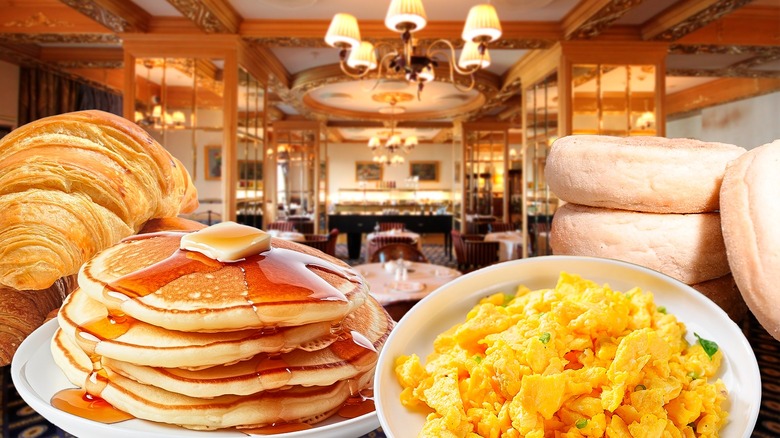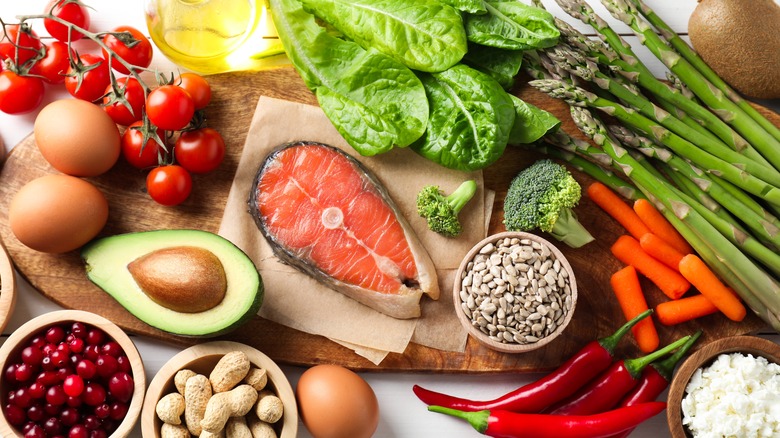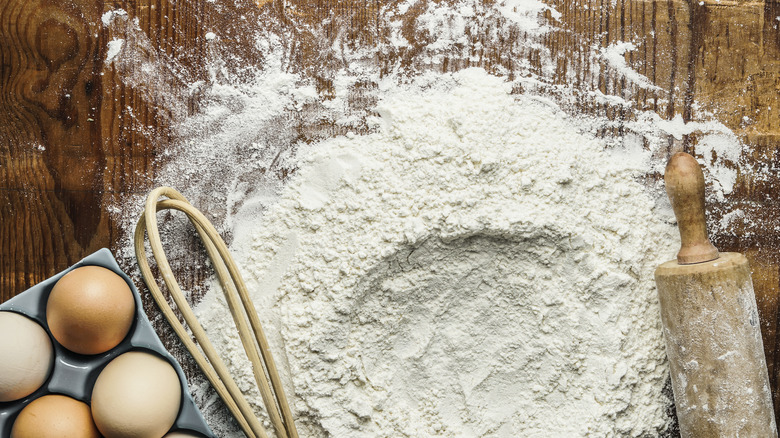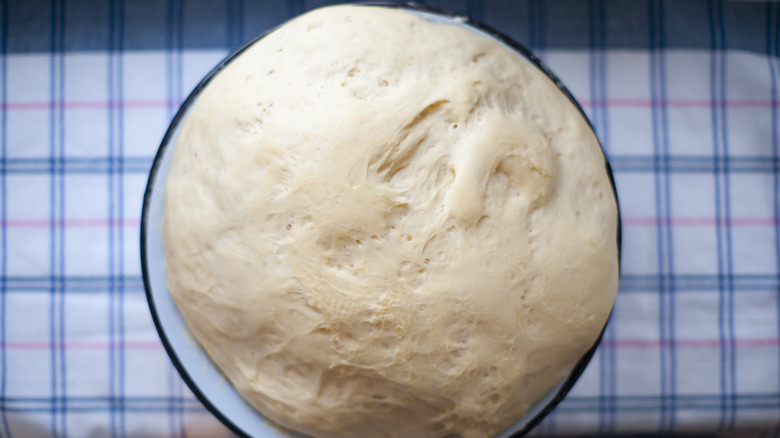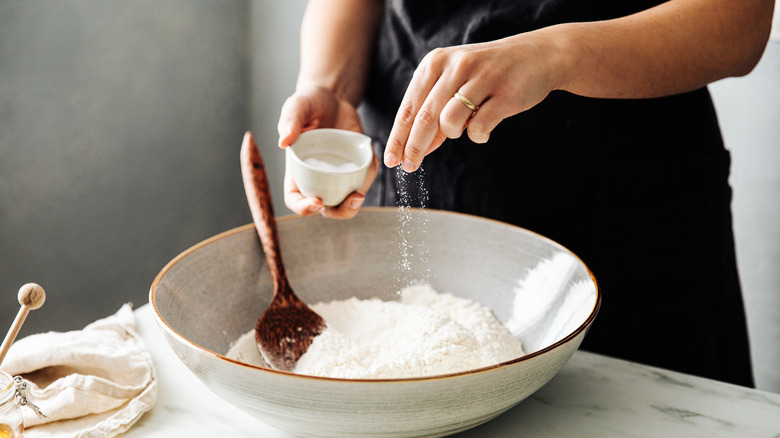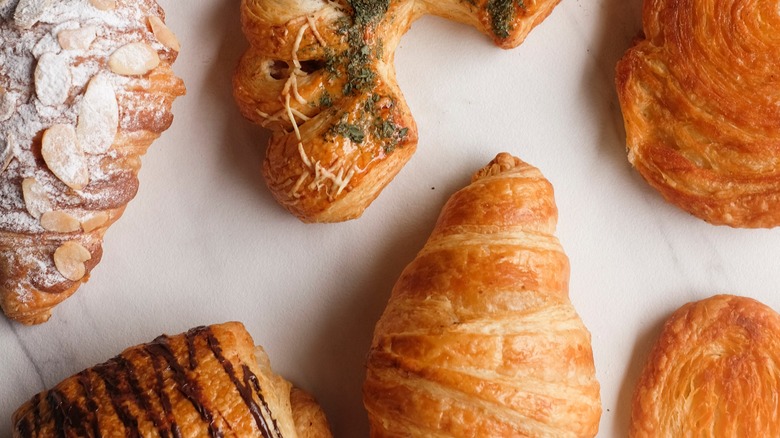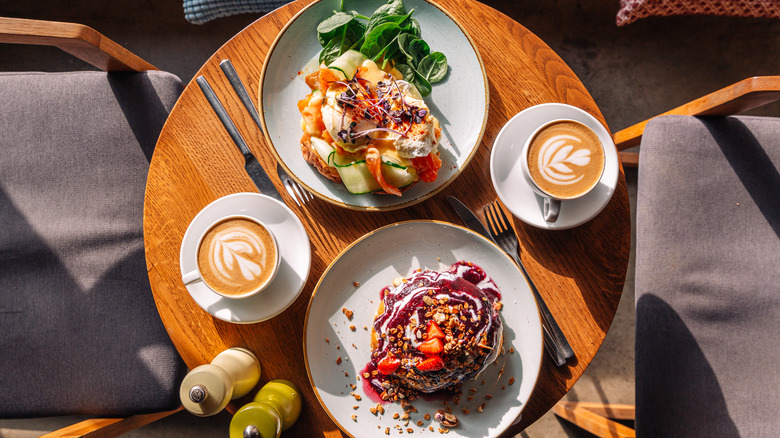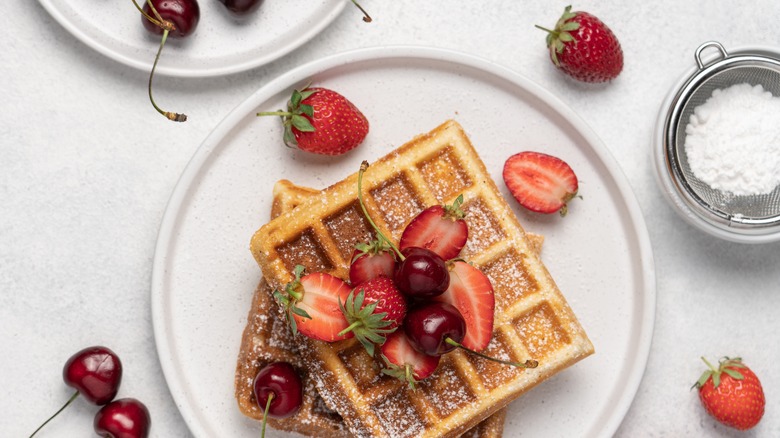Why These Breakfast Foods Always Taste Better At Restaurants
Nothing sets the tone for your day quite like breakfast. Whether it's homemade flapjacks with all the trimmings on a lazy Sunday morning or your favorite Starbucks sandwich on the go, there's no dismissing the impact that first meal can have. But for all the breakfast and brunch recipes you try at home, some days you just have to admit that you can't crack it quite like your local breakfast spot — maybe you can't get your cinnamon rolls quite as soft or you can't get your flapjacks quite as fluffy.
Restaurants have a knack for making the best meal of the day even better, but you don't have to let that take away from your culinary experience at home. Small adjustments to your home-cooked breakfasts can make all the difference, whether it's adding a pinch of salt to your waffle batter to enhance the sweetness, opting for high-quality ingredients like 100% butter or farm-fresh eggs for an unbeatable texture in your baked goods, or tweaking your cooking processes.
With some insider knowledge and a little practice, you can enhance any breakfast dish because many hacks and techniques used in restaurants can be mastered in your own home. With these tips from the pros, you'll discover why certain breakfast foods taste so good at restaurants and learn some techniques for achieving similar results from the familiarity of your own kitchen (well, almost).
They are made with fresh ingredients
As with all good food, fresh ingredients make all the difference when it comes to the final product. It's pretty much guaranteed that good restaurants use fresh ingredients in order to serve delicious, superior-quality food. When it comes to breakfast, think farm-fresh eggs, buttery soft avocados, and fresh fruit, to name a few examples. Fresh ingredients often taste better than processed equivalents, and they're also an easy way to incorporate some high-quality nutrition and fiber.
Breakfast is possibly the easiest meal of the day to elevate with just one simple addition. Seasonal herbs like basil or chives can make a marked improvement in the flavor profile of any omelet. Even something as simple as a glass of recently squeezed orange juice completely transforms the start of your day.
Beyond having better flavor, fresh ingredients can affect the textural aspect of your breakfast too. Perfectly ripe avocados are beautifully creamy, fresh berries over frozen add a zesty pop, and high-quality salmon on a breakfast bagel simply melts in your mouth.
Baked goods are made fresh
Breakfast isn't complete without some form of bread. And in keeping with the practice of using fresh ingredients, fresh bread is always best. When you walk into your favorite breakfast spot and you are met with the toasty, buttery smell of baked bread and pastries, you already know you are in for a treat. Whether you're having a cream cheese and salmon bagel or a sweet breakfast with banana bread, a newly baked base is vital for the ideal restaurant experience.
Fresh bread smells and tastes so divine thanks to the Maillard reaction, the same process that creates a beautifully caramelized steak. During baking, the outer part of the dough is exposed to super high temperatures, reaching over 400 degrees Fahrenheit, while the inside never passes the boiling point of water. The result is a chemical reaction on the outermost surface, resulting in a deliciously browned hard crust. When eaten fresh, you can still smell the Maillard reaction at work, making for a next-level tasty breakfast.
So if you're set on cooking up a breakfast to rival that of your favorite cafe, consider making your own bread. Most homemade breads will be good for two to four days before they lose their springiness and become unpleasantly dry and crunchy. Of course, how long a loaf of bread lasts depends a lot on the type of bread and how you store it for long-lasting freshness (as well as your level of self-control).
High-quality ingredients are used
Using high-quality ingredients is non-negotiable if you're after restaurant-quality breakfast at home. For example, restaurants typically invest in premium butter for flavor, explained Rhiannon Abbott, owner of The Epsom Bakehouse. Whether you're whipping up pancakes or waffles, frying eggs, or making a delectable hollandaise sauce, good ol' traditional butter is irreplaceable.
The same rings true for all ingredients. If your goal is a restaurant breakfast at home, don't skimp on the building blocks. You might be tempted to opt for the cheapest option when you're browsing ingredients, and while there are some ingredients chefs buy cheap, there are certain ones that are worth the higher prices. When it comes to breakfast bakes, "go for as high-quality ingredients as you can," Abbott said. Your tastebuds will thank you. Spending a little extra money on ingredients like olive oil, butter, and vanilla will help you get that depth of flavor that makes restaurant breakfast items so tasty.
Chefs bake with various flours
Restaurants and cafes know all the tricks to elevate their dishes and keep you coming back, and one of the hacks lesser known to patrons is using different types of flour for different baked goods. When you get into the world of baking at home, there will be plenty of opportunities to experiment with different recipes.
You'll find that different bakes call for different varieties of flour (think bread flour versus cake flour). There's a good reason for that; bread flour typically contains more protein than other flour types. "Some of that protein will become gluten in your final loaf, acting like the scaffold of your bread to produce a well-risen loaf," Rhiannon Abbott explained. Fluffy breads are the result of lower protein flours such as cake or plain flour, "but you may find that your dough consistency changes and, for certain breads, your loaf may not rise as well as expected," she said.
Different types of flour also create different tastes and qualities when used in baked goods. "Flours can really vary in flavor," Abbot said. "Try sourcing directly from a mill or trying stoneground flour for the first time." Stoneground flour is a classic example of how flour can change the flavor of the final product. According to Abbott, it retains flavor from the outer bran of the grain, making for delicious breads. It's insider knowledge like this that can help you achieve restaurant-quality breakfasts and brunches from the comfort of your home.
Dough is allowed the time to rise correctly
There's nothing like a perfectly soft, fluffy brioche or a seamlessly spongy English muffin, and there's no doubt all the best breakfast places get it spot on every time. But these breakfast beauties don't happen unintentionally. All bread (including breakfast favorites) needs to rise properly to develop the perfect texture and taste, and whether restaurants source their bread or make it fresh in-house, you can bet the dough was able to rise properly. If you want to emulate a restaurant breakfast yourself, letting your dough rise is a must. "When baking bread at home, leaving the dough to rise for long enough helps develop wonderful flavors in the finished bread," Rhiannon Abbott said.
Proofing your bread, as it is called, allows the dough to fill out with gas, resulting in a light crumb in your final loaf. "Not letting your dough rise enough could result in a dense and heavy bread that may not bake through," Abbott said. You can tell your dough has risen enough if it has doubled in size and it springs back if you lightly poke it.
A tried-and-true method to improve the taste and texture of your home-baked bread is to use a baking technique called a preferment, where you mix flour, water, and yeast and allow it to ferment overnight before adding it to the rest of your dough. Doing this extends your rising time, allowing for deep flavors and beautifully springy textures.
They are made with salt
Any good restaurant knows the power of salt and the impact it can have on the overall dish and flavor balance. Whether it's to perfectly season a zingy shakshuka or to incorporate it into bread dough for a fluffy, sweet final product, salt is a must-have ingredient if you want restaurant-quality food at home.
It's not uncommon for many baking recipes to call for a pinch of salt and that's because salt is a flavor enhancer that can even make food taste sweeter. "Whilst breakfast bakes such as cinnamon buns are seen as sweet treats, be sure to include salt in your bread dough too," Rhiannon Abbott said.
Adding just a touch of salt to your breakfast muffins or pancake batter will allow the sweetness to sing, but it can also impact the result in terms of texture. "Salt helps create flavor in your dough and also strengthens the gluten network in your dough, helping the dough to rise well and produce a soft, fluffy final bread," Abbott said.
Unique pastries offer a wide variety of choices
Croissants, English muffins, danishes, cinnamon rolls — the list of breakfast pastries available at restaurants is sizable, to say the least, and that's part of what makes a breakfast out so good. Being able to request the exact pastry you're hankering for without the hassle of having to make it is a huge appeal when it comes to eating out. The textures, fillings, and signature designs all come together in a wonderful piece of art to enjoy with every mouthful. Many of these recipes have been passed down through generations and tweaked with technical expertise to absolute perfection.
"There's so much variety between different restaurant breakfasts and that can be part of the treat," Rhiannon Abbott said. One of her favorite breakfast pastries is ensaïmadas, a pastry popular in Mallorca, Spain and the Balearic Islands. "These are traditionally made with lard to create delicate, soft layered pastries full of flavor and dusted with icing sugar. Delicious!" she said.
Professional menu designs and technical execution are used
The concept of eating with your eyes first exists for good reason. Having your breakfast beautifully plated in front of you before you tuck in can also make it taste better. And it's no surprise that the technical know-how of a reputable dining establishment makes for expertly put-together dishes. All of this to say, the restaurant experience itself can affect the way your tastebuds receive and appreciate flavor.
From the moment you walk through the door, all aspects of the restaurant environment are meant to add to the dining experience and will influence the way you receive the meal. As you enter the establishment, you're met with the sweet aroma of waffles or the deep full-bodied smell of freshly roasted coffee. Your brain is firing off signals and building excitement that lends itself to expecting good tastes to be on their way shortly.
But beyond that, dining out is so good because of the expertise and processes present in a commercial kitchen, particularly when it comes to breakfast dishes that often consist of several elements to prepare. "In a professional environment, each component is cooked in large batches, with some elements prepared to 90% and only needing a final touch when ordered by a customer," explained Amir Mousavi, Food Consultant at Good Food Studio London. "Each component is given the right time and method to cook optimally by a team well-versed in how to do so."
They are made on commercial cooking equipment
A commercial kitchen has access to equipment that even the most enthusiastic home cooks can only dream of installing. And when it comes to breakfast, pancakes and waffles taste better at restaurants than at home than at home because of a piping hot griddle ready for the batter.
"At home, you have to cook each element from scratch with limited kitchen space," said Amir Mousavi. "Sacrifices will have to be made, either by juggling the pans you have or opting for a 'one-pan' method." Without enough hot pans, you can't easily execute each element well and time everything to end up on your plate hot and perfectly done, which equates to an inferior experience when compared to restaurants.
Ultimately, you can invest in the best ingredients and experiment with any number of breakfast dishes, but you're limited by your kitchen equipment and the unfortunate fact that you don't have a team of expert chefs working with you.
